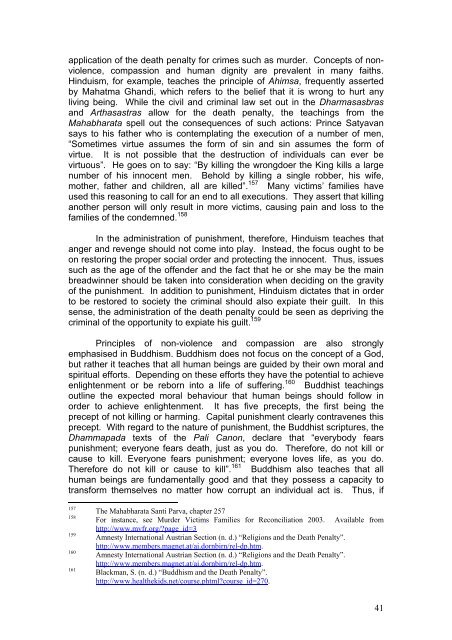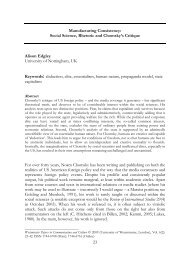application <strong>of</strong> the death penalty for crimes such as murder. Concepts <strong>of</strong> nonviolence,compassion and human dignity are prevalent in many faiths.Hinduism, for example, teaches the principle <strong>of</strong> Ahimsa, frequently assertedby Mahatma Ghandi, which refers to the belief that it is wrong to hurt anyliving being. While the civil and criminal law set out in the Dharmasasbrasand Arthasastras allow for the death penalty, the teachings from theMahabharata spell out the consequences <strong>of</strong> such actions: Prince Satyavansays to his father who is contemplating the execution <strong>of</strong> a number <strong>of</strong> men,“Sometimes virtue assumes the form <strong>of</strong> sin and sin assumes the form <strong>of</strong>virtue. It is not possible that the destruction <strong>of</strong> individuals can ever bevirtuous”. He goes on to say: “By killing the wrongdoer the King kills a largenumber <strong>of</strong> his innocent men. Behold by killing a single robber, his wife,mother, father and children, all are killed”. 157 Many victims’ families haveused this reasoning to call for an end to all executions. They assert that killinganother person will only result in more victims, causing pain and loss to thefamilies <strong>of</strong> the condemned. 158In the administration <strong>of</strong> punishment, therefore, Hinduism teaches thatanger and revenge should not come into play. Instead, the focus ought to beon restoring the proper social order and protecting the innocent. Thus, issuessuch as the age <strong>of</strong> the <strong>of</strong>fender and the fact that he or she may be the mainbreadwinner should be taken into consideration when deciding on the gravity<strong>of</strong> the punishment. In addition to punishment, Hinduism dictates that in orderto be restored to society the criminal should also expiate their guilt. In thissense, the administration <strong>of</strong> the death penalty could be seen as depriving thecriminal <strong>of</strong> the opportunity to expiate his guilt. 159Principles <strong>of</strong> non-violence and compassion are also stronglyemphasised in Buddhism. Buddhism does not focus on the concept <strong>of</strong> a God,but rather it teaches that all human beings are guided by their own moral andspiritual efforts. Depending on these efforts they have the potential to achieveenlightenment or be reborn into a life <strong>of</strong> suffering. 160 Buddhist teachingsoutline the expected moral behaviour that human beings should follow inorder to achieve enlightenment. It has five precepts, the first being theprecept <strong>of</strong> not killing or harming. Capital punishment clearly contravenes thisprecept. With regard to the nature <strong>of</strong> punishment, the Buddhist scriptures, theDhammapada texts <strong>of</strong> the Pali Canon, declare that “everybody fearspunishment; everyone fears death, just as you do. Therefore, do not kill orcause to kill. Everyone fears punishment; everyone loves life, as you do.Therefore do not kill or cause to kill”. 161 Buddhism also teaches that allhuman beings are fundamentally good and that they possess a capacity totransform themselves no matter how corrupt an individual act is. Thus, if157158159160161The Mahabharata Santi Parva, chapter 257For instance, see Murder Victims Families for Reconciliation 2003. Available fromhttp://www.mvfr.org/?page_id=3Amnesty International Austrian Section (n. d.) “Religions and the Death Penalty”.http://www.members.magnet.at/ai.dornbirn/rel-dp.htm.Amnesty International Austrian Section (n. d.) “Religions and the Death Penalty”.http://www.members.magnet.at/ai.dornbirn/rel-dp.htm.Blackman, S. (n. d.) “Buddhism and the Death Penalty”.http://www.healthekids.net/course.phtml?course_id=270.41
punishment is to be administered, it should be done in a spirit <strong>of</strong> compassionwith a view to rehabilitation.The idea <strong>of</strong> rehabilitating an <strong>of</strong>fender goes to the heart <strong>of</strong> the debateabout the purpose <strong>of</strong> the penal system and has been acknowledged by anumber <strong>of</strong> religious leaders. In a statement supporting a moratorium on thedeath penalty, His Holiness, Tenzin Gyatso, The Fourteenth Dalai Lama,expressed his concern about the revengeful nature <strong>of</strong> the death penalty.Although fulfilling the preventive function, he emphasised that it is anespecially severe form <strong>of</strong> punishment because it is so final and because theperson is deprived <strong>of</strong> the opportunity to change, to restore the harm done orto compensate for it. 162 Similar statements have been made in the CatholicChurch: in 1999 Pope Jean Paul II, on a visit to Missouri, USA, affirmed thatthe “dignity <strong>of</strong> human life must never be taken away, even in the case <strong>of</strong>someone who has done great evil. Modern society has the means <strong>of</strong>protecting itself, without denying criminals the chance to reform”. 163In light <strong>of</strong> these teachings, it is surprising that countries withpredominantly Buddhist populations such as China, Thailand, Korea, Taiwanand Japan continue to apply the death penalty. Of course, it is necessary forany society, including those with large Buddhist populations, to have somecodes relating to crime and punishment, which are administered by humanbeings on other human beings. Indeed, fishermen engage in killing othercreatures, as do some farmers. The way a person earns his or her livelihoodmay not sit comfortably with the first Buddhist precept <strong>of</strong> not killing or harming.As one author notes, even during the time <strong>of</strong> Buddha both Buddhism andsecular organisations did coexist; important military chiefs and public figureswere devout followers <strong>of</strong> Buddhism. Although from a Buddhist point <strong>of</strong> viewthe destruction <strong>of</strong> life can never be condoned, a person can only practice hisor her religion according to his or her ability, opportunity and duty. Withregard to law enforcement <strong>of</strong>ficials, one should recognise that their occupationmay involve killing in the line <strong>of</strong> duty, directly or indirectly. While killing wouldnot be conducive to their spiritual well-being, it is possible to practice theBuddhist precepts in other areas <strong>of</strong> their life. 164There are concerns that in the world’s most populous countryIndonesia other religious minorities are treated differently under the law. Onesuch example which has been highlighted is the aftermath to the wave <strong>of</strong>violence which broke out between Christians and Muslims in the Sulawesiregion in 1998, where several people from the Christian militia weresentenced to death, whereas only a handful <strong>of</strong> Muslims were convicted andsentenced, and no one to more than 15 years. 165162163164165Gyatso, T., His holiness, The Fourteenth Dalai Lama (n. d.) “Message Supporting theMoratorium on the Death Penalty”. http://www.engaged-zen.org/HHDLMSG.html.Papal Mass, St. Louis, Missouri, 27 January 1999.http://www.nccbuscc.org/sdwp/national/criminal/stlouissmt.htm.Plamintr, S. (n. d.) “Getting To Know Buddhism”.http://www.geocities.com/Athens/Academy/9280/getting.htm.‘Executions spark Indonesia unrest’ published 22 September 2006http://news.bbc.co.uk/1/hi/world/asia-pacific/5368922.stm42
- Page 1 and 2: CAPITAL PUNISHMENTBRIEFING PAPERPet
- Page 3 and 4: PETER HODGKINSON, OBEDirector, Cent
- Page 5 and 6: Subsequently, she worked at the Cen
- Page 7 and 8: Preamble 1The objective of this bri
- Page 9 and 10: a unique deterrent, 3] the administ
- Page 11 and 12: effects’ are not uncommon even in
- Page 13 and 14: debate, not hide behind the views o
- Page 15 and 16: place with tougher institutions for
- Page 17 and 18: supported capital punishment. The p
- Page 19 and 20: Death Penalty for MurderRed = major
- Page 21 and 22: prosecutors had withheld evidence,
- Page 23 and 24: By comparison, Europe is almost ent
- Page 25 and 26: have very low rates of recidivism a
- Page 27 and 28: It will be interesting to see how t
- Page 29 and 30: While some death penalty opponents
- Page 31 and 32: manifest itself in the often violen
- Page 33 and 34: death row, which was more than the
- Page 35 and 36: would be to obtain a complete suspe
- Page 37 and 38: developed largely through the impro
- Page 39 and 40: Religion and capital punishment[sec
- Page 41: automatically. For example, in case
- Page 45 and 46: money). Given the victim-orientated
- Page 47 and 48: certifying death, removing organs f
- Page 49 and 50: The WPA held that “the participat
- Page 51 and 52: Mental health and the death penalty
- Page 53 and 54: sparse and apparently limited to ge
- Page 55 and 56: Table 2: Elements of death penalty
- Page 57 and 58: squad on the grounds that beheading
- Page 59 and 60: It was on the grounds of physician
- Page 61 and 62: The Protocol to the American Conven
- Page 63 and 64: is an integral part of the state, t
- Page 65 and 66: The Jamaican debate has taken place
- Page 67 and 68: Privy Council 252 describing the ef
- Page 69 and 70: sentence. 274 Those were sentences
- Page 71 and 72: The situation in MoroccoLegal Syste
- Page 73 and 74: continue to pass death sentences, P
- Page 75 and 76: Prison conditionsThe conditions of
- Page 77 and 78: people were sentenced to death in E
- Page 79 and 80: In Mali, the mandatory waiting peri
- Page 81 and 82: Execution data and processIn Vietna
- Page 83 and 84: Drugs and the death penalty - confu
- Page 85 and 86: 1.2% of Indonesia’s 210 million p
- Page 87 and 88: APPENDIX ONESTATUS OF THE DEATH PEN
- Page 89 and 90: NEPAL 1997 1990 1979NETHERLANDS 198
- Page 91 and 92: The Russian Federation introduced a
- Page 93 and 94:
De Facto abolitionist*Korea (South)
- Page 95 and 96:
Guinea R R R N R RGuinea b S S R S
- Page 97 and 98:
Thailand R R R R R RYugoslav R R R
- Page 99 and 100:
violent crimes such as rape, murder
















